“Little did they expect such resistance” – this sentence, while seemingly simple, utilizes a powerful grammatical tool: inversion. This structure, though not as common as others, can significantly enhance your writing and speaking, especially in the IELTS exam. Let’s explore how.
Here are some examples of inversion used in different sections of the IELTS:
Speaking:
-
“Seldom do I eat fast food, as I prefer home-cooked meals.” (Speaking Part 1 – Talking about eating habits)
-
“Not only does cycling improve fitness, but it also reduces pollution.” (Speaking Part 3 – Discussing benefits of cycling)
Writing:
-
“Were the government to invest more in renewable energy, we could combat climate change effectively.” (Writing Task 2 – Essay on renewable energy)
-
“Had I known about the traffic jam, I would have taken an alternate route.” (Writing Task 1 – Letter of apology for being late)
In each example, notice how the auxiliary verb is placed before the subject, creating a more formal and emphatic tone. This is the hallmark of inversion.
Understanding Inversion and its Significance in IELTS
Inversion is a grammatical structure where the auxiliary verb comes before the subject, deviating from the standard subject-verb-object order. It is often used for emphasis, formality, or stylistic effect. Mastering this structure can significantly boost your IELTS score by demonstrating a sophisticated grasp of English grammar.
Mastering the “Little Did They…” Structure
Formula:
Little/Rarely/Never/Seldom/Not only + Auxiliary Verb + Subject + Main Verb
Analysis:
This specific type of inversion is used to emphasize negative adverbs like “little,” “rarely,” “never,” etc.
- “Little” in this context means “not at all.”
- The auxiliary verb depends on the tense of the main verb. For example, in the sentence “Little did they know…,” the main verb “know” is in the past tense, so the auxiliary verb “did” is used.
- The subject follows the auxiliary verb.
- The main verb comes after the subject.
IELTS Application:
This structure is particularly effective in Writing Task 2 when expressing contrasting ideas or unexpected situations.
Example:
Original: They didn’t expect such a strong backlash from the public.
Inversion: Little did they expect such a strong backlash from the public.
The inversion adds a touch of drama and sophistication, highlighting the unexpected nature of the public’s reaction.

Enhancing Your Writing with Inversion
Beyond “Little”:
Inversion is not limited to “little.” Explore other negative adverbs like “rarely,” “seldom,” “never,” and “hardly.”
Examples:
- Rarely do we see such dedication to a cause.
- Never before have I witnessed such a breathtaking sunset.
Not Only…But Also:
Use inversion with “not only…but also” to emphasize a dual aspect.
Example:
- Not only does this policy harm the environment, but it also stifles economic growth.
Conditional Statements:
Use inversion in conditional statements to create a more formal and hypothetical tone.
Example:
- Were we to address climate change effectively, we must act now.
Common Pitfalls and How to Avoid Them
While inversion is a powerful tool, incorrect usage can lower your score. Here are some common errors:
- Incorrect Verb Placement: Ensure the auxiliary verb comes before the subject.
- Tense Confusion: Match the auxiliary verb with the tense of the main verb.
- Overuse: Use inversion sparingly for impact, not in every sentence.
Conclusion
Mastering inversion, particularly structures like “little did they expect,” can elevate your IELTS writing and speaking, showcasing a strong command of grammar and style. Remember to use it strategically, practice regularly, and avoid common errors. With dedicated effort, you can wield this grammatical tool effectively and achieve your desired IELTS score.